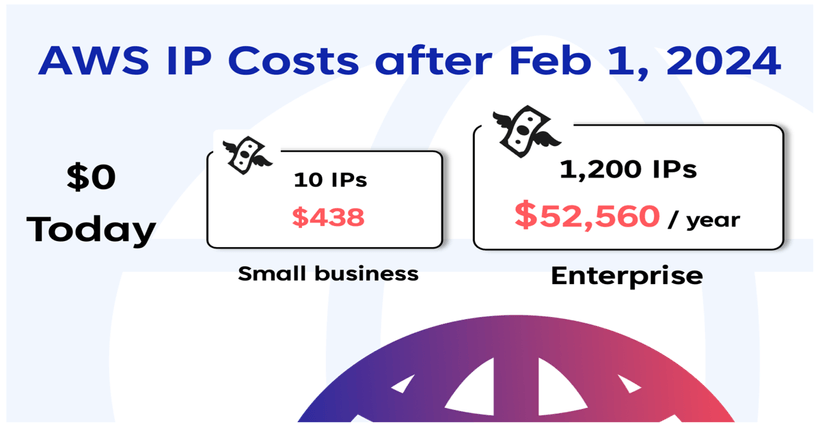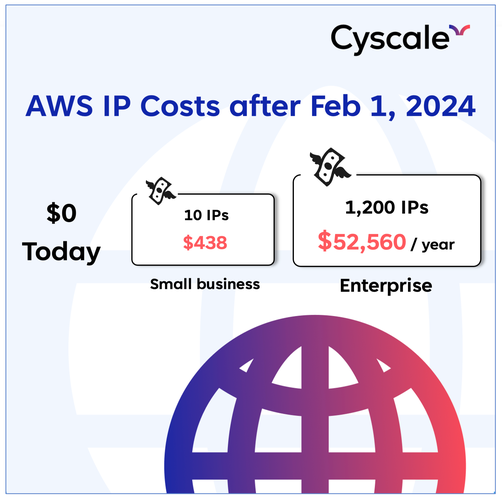IPv4 Billing Changes in AWS: Impact on Cloud Costs & Security
Cloud Architect at Cyscale
Thursday, August 31, 2023

Note: post updated January 30, 2024
Beginning February 1, 2024, Amazon Web Services (AWS) will usher in a significant change by charging for public IPv4 addresses. Whether you are a seasoned cloud engineer or a business decision-maker this shift by one of the world's leading cloud providers will likely have broad implications.
AWS's decision aligns with other major cloud providers that have adopted similar practices, reflecting an industry-wide trend. AWS's involvement is particularly significant given its substantial market presence, and it will likely influence various organizations across different scales and industries.
In terms of your business and the tech landscape, this change goes beyond additional costs, with the new model affecting network planning, igniting considerations about transitioning to IPv6, and opening opportunities to reassess cloud security strategies.
The Financial Implications of AWS's New Charging Model for IPv4 Addresses
Detailed Explanation of Pricing

Starting February 1, 2024, AWS will charge for all public IPv4 addresses at a rate of 0.5 cents per hour. While this figure may initially seem inconsequential, it is vital to understand how swiftly it can accumulate.
For small businesses or individual projects, the impact might be marginal. Our example considers a small organization with 10 public IP addresses:
10 IPs x 0.5 cents per hour x 730 hours in a month = $36.5 per month, or $438 per year.
Contrast this with an enterprise operating with 11,000 public IPs:
11,000 IPs x 0.5 cents per hour x 730 hours in a month = $40,150 per month, or nearly $500,000 per year.
11,000 IP addresses might sound like an overestimation, but we are seeing organizations with tens of thousands of EC2 instances. Assuming 20-30% of these need public IPs is not out of reach.
This striking difference highlights the importance of understanding and planning for the financial consequences, particularly for organizations heavily reliant on public IPv4 addresses.
Budget Considerations for Organizations
AWS's decision to charge for public IPv4 addresses extends beyond a simple financial concern; it prompts businesses to reevaluate their entire approach to IP address utilization. Key considerations include:
- Reviewing existing usage: Analyzing current usage patterns is essential for predicting additional costs and identifying opportunities for optimization.
- Considering IPv6 migration: Some may find transitioning to IPv6 a cost-effective alternative, though it must be balanced against compatibility and technical constraints.
- Utilizing tools and insights: Automated security platforms like Cyscale can offer comprehensive insights into your inventory of public IP addresses, helping you understand the big picture and delivering insight that can aid in cost control.
This policy change serves as a catalyst for reimagining how organizations approach cloud infrastructure financially. The ripple effects will be felt differently across the spectrum, but the core message is clear: understanding, planning, and adapting will be pivotal in navigating this change without unforeseen financial setbacks.
Whether you are a decision-maker concerned about the bottom line or a cloud professional tasked with optimization, these changes necessitate close scrutiny and proactive planning.
Technical Aspects and Considerations
Impact on EC2 Instances, RDS, EKS, etc.
The new charging model impacts a broad array of resources, including EC2 instances, RDS, EKS, load balancers, and more. Managing complex architectures now entails a new layer of complexity, possibly requiring a reassessment of networking strategies and configurations.
The Complexity of Managing Multiple IP Addresses per Resource
Some resources may have more than one public IPv4 address. Managing these involves not just technical configuration but also financial planning. Understanding how these multiple IPs interact within your infrastructure and contribute to overall costs is essential.
Discussion on the Feasibility and Challenges of Switching to IPv6
The move to IPv6 seems logical, but it's not devoid of challenges. Compatibility with services and APIs managed by others might become a hurdle. AWS has made progress, such as enabling communication from EC2 to Lambda functions over IPv6 (note that you cannot reach an EC2 instance from Lambda over IPv6), yet some cases may still hinder a complete switch.
IPv4 to IPv6 Transition Mechanisms
During the transition, Network Address Translation (NAT), specifically NAT64, becomes vital. This mechanism translates IPv6 to IPv4 addresses, bridging communication between newer IPv6 systems and legacy IPv4 systems. Understanding and utilizing NAT64 is crucial for modernizing without losing functionality. Equally important is DNS64 which performs the translation at the DNS level. More specifically, in the case a domain is mapped only to an IPv4 address (i.e., it only has A records), DNS64 translates an A record (specific to IPv4) to an AAAA record (specific to IPv6), thus allowing an IPv6 client to reach an IPv4 server.
Proficiency with Security Groups and Other Network Considerations
With all IPv6 addresses being public, mastering security groups and leveraging egress-only internet gateways become even more critical. Properly configuring security rules and comprehending their interaction with different IP versions plays a significant role in upholding security and functionality within your network.
The new AWS charging model for public IPv4 addresses is more than a financial consideration. It intertwines with a multifaceted web of technical aspects that must be thoughtfully navigated. Embracing the right strategies and tools can pave the way for a seamless transition, preserving both efficiency and budget.
Security Implications
Reevaluation of Network Exposure
The new charges for public IPv4 addresses might encourage organizations to scrutinize network exposure more closely. Reducing the number of public IPs could be both a cost-saving measure and a strategy to enhance security by limiting the attack surface.
Importance of Secure Configuration in IPv6 Transition
Transitioning to IPv6, while potentially cost-effective, demands careful consideration of security configurations. Understanding IPv6 security nuances is vital in safeguarding systems during and after the shift. While NAT64 facilitates communication between IPv6 and IPv4 systems, it also introduces unique security considerations. Proper implementation and continuous vigilance are required to ward off vulnerabilities that might arise during the translation process. In practice, most organizations will leverage the AWS NAT Gateway which already supports NAT64 and DNS64 (through Route 53) so our responsibility includes proper route configuration and keeping DNS resolvers up to date. However, other organizations might choose to deploy their own NAT instance to optimize cost.
Tools and Platforms for Security Management
Automated cloud security platforms like Cyscale can play a pivotal role in this secure transition. By providing insights into all public IP addresses, their attachments, and alternative communication paths, they can facilitate a more secure and cost-effective migration. Utilizing specialized security platforms and tools is fundamental to maintaining control over complex cloud environments.
This new AWS charging model for public IPv4 addresses is more than a technical and financial hurdle; it's an opportunity to rethink and potentially enhance security strategies. By understanding the interplay between IPv4 and IPv6, the role of the transition mechanisms, and the necessity of proper security configurations, organizations can navigate this transition without compromising security.
The Role of Cloud Security Platforms
Automated cloud security platforms like Cyscale are more than just a reactive measure to changes like AWS's new charging model for public IPv4 addresses; they represent a proactive approach to modern cloud infrastructure management. By providing tools that cut across cost optimization, security enhancement, migration planning, and collaboration, these holistic solutions enable organizations to thrive in an evolving cloud landscape.
Cloud Architect @ Cyscale
Specializing in cloud solutions and software engineering, Andrei applies his skills to create scalable, secure systems at Cyscale. His passion for technology and education drives him to contribute valuable insights into cloud-native technologies, benefitting the company’s product engineering efforts.
Further reading
Cloud Storage
Misconfigurations

Build and maintain a strong
Security Program from the start.
Cloud Compliance in
2025: An In-Depth Guide
The whitepaper talks about ISO 27001, SOC 2, PCI-DSS, GDPR, HIPAA.
Download WhitepaperShare this article
Stay Connected
Receive our latest blog posts and product updates.
TOP ARTICLES
Cloud Security
Our Compliance toolbox
Check out our compliance platform for cloud-native and cloud-first organizations:

LATEST ARTICLES
What we’re up to

Why the world needs Cyscale in a post-Wiz era




